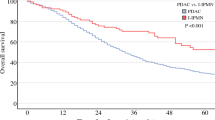Abstract
Background
The incidence of secondary malignancies is increased in patients with malignant and premalignant conditions. Although neuroendocrine tumors (NET) are uncommon, their incidence is increasing. We evaluated the rate of additional malignancies in patients with NET.
Methods
Using the Surveillance, Epidemiology, and End Results (SEER) database, we identified a cohort of patients with pancreatic NET (PNET) or gastrointestinal NET (GINET). We determined the incidence of additional cancers diagnosed either before or after the diagnosis of PNET or GINET, by comparing these rates with the general population. Using multivariable regression, we evaluated factors that increased the risk of an additional malignancy.
Results
A cohort of 9,727 NET patients was identified. A total of 3,086 additional cancers occurred in 2,508 patients (25.8 %). The most common sites of additional malignancies included colorectal (21.1 %), prostate (14.5 %), breast (13.3 %), and lung (11.6 %). Among patients with PNET, the incidence of breast, lung, uterine, lymph, and pancreatic cancers was less than expected in the general population, whereas in patients with GINET, the observed incidence of nearly all malignancies exceeded that expected. Increasing age, marital status, and localized NET were associated with increased risk.
Conclusion
Our study shows that the incidence of additional malignancies in patients with PNET and GINET is 25.8 %. Patients with GINET are at increased risk of additional malignancies, whereas patients with PNET have a decreased risk compared with the general population. More vigilant surveillance for secondary malignancies should be performed in patients with GINET. Studies investigating potential etiologic oncogenic pathways are warranted.
Similar content being viewed by others
References
Yao JC, Hassan M, Phan A, et al. One hundred years after “carcinoid”: epidemiology of and prognostic factors for neuroendocrine tumors in 35,825 cases in the United States. J Clin Oncol. 2008;26:3063–72.
Oberg K, Castellano D. Current knowledge on diagnosis and staging of neuroendocrine tumors. Cancer Metastasis Rev. 2011;30(Suppl. 1):3–7.
Trentham-Dietz A, Newcomb PA, Nichols HB, et al. Breast cancer risk factors and second primary malignancies among women with breast cancer. Br Cancer Res Treat. 2007;105:195–207.
Lubensky IA, Pack S, Ault D, et al. Multiple neuroendocrine tumors of the pancreas in von Hippel–Lindau disease patients. Am J Pathol. 1998;153:223–31.
Habal N, Sims C, Bilchik AJ. Gastrointestinal carcinoid tumors and second primary malignancies. J Surg Oncol. 2000;75:310–6.
Aggarwal G, Obideen K, Wehbi M. Carcinoid tumors: what should increase our suspicion? Clevel Clin J Med. 2008;75:849–55.
Tichansky DS, Cagir B, Borrazzo E, et al. Risk of second cancers in patients with colorectal carcinoids. Dis Colon Rectum. 2002;45:91–7.
Kamp K, Damhuis RA, Felders RA, de Herder WW. Occurrence of second primary malignancies in patients with neuroendocrine tumors of the digestive tract and pancreas. Endocr Relat Cancer. 2012;19:95–9.
Surveillance, Epidemiology, and End Results. http://seer.cancer.gov. Accessed 15 April 2012.
Surveillance, Epidemiology, and End Results (SEER) Program. http://www.seer.cancer.gov. Research data (1973–2008). National Cancer Institute, DCCPS, Surveillance Research Program, Surveillance Systems Branch, released April 2011, based on November 2010 submission.
Riall TS, Stager VM, Nealon WH, et al. Incidence of additional primary cancers in patients with invasive intraductal papillary mucinous neoplasms and sporadic pancreatic adenocarcinomas. J Am Coll Surg. 2007;204:803–13.
US Cancer Statistics Working Group. http://www.apps.nccd.cdc.gov/uscs/cancersbyraceandethnicity.aspx. United States Cancer Statistics: 1999–2008 Incidence and Mortality Web-based Report. Atlanta: US Department of Health and Human Services, Center for Disease Control and Prevention and National Cancer Institute. Accessed 27 November 2012.
US Census. http://www.quickfacts.census.gov/qfd/states/00000.html. Accessed 14 June 2012.
Shebani KO, Souba WW, Finkelstein DM, et al. Prognosis and survival in patients with gastrointestinal tract carcinoid tumors. Ann Surg. 1999;229:815–21.
Fischer L, Kleef J, Esposito I, et al. Clinical outcome and long-term survival in 118 consecutive patients with neuroendocrine tumours of the pancreas. Br J Surg. 2008;95:627–35.
Tsai HJ, Wu CC, Tsai CR, et al. Second cancers in patients with neuroendocrine tumors. PLoS One. 2013;8:e86414.
Wang L, Wilson SE, Stewart DB, et al. Marital status and colon cancer outcomes in US Surveillance, Epidemiology, and End Results registries: does marriage affect cancer survival by gender and age? Can Epidemiol. 2011;35:417–22.
Baine M, Sahak F, Lin C, et al. Marital status and survival in pancreatic cancer patients: a SEER based analysis. PLoS One. 2011;6:E21052.
Zhu K, Weiss NS, Schwartz SM, et al. Assessing the relationship between marital status and cancer incidence: methodologic considerations. Cancer Causes Control. 1994;5:83–7.
Silber JH, Rosenbaum PR, Clark AS, et al. Characteristics associated with differences in survival among black and white women with breast cancer. JAMA. 2013;310:389–97.
Clegg LX, Li FP, Hankey BF, Chu K, Edwards BK. Cancer survival among US whites and minorities: a SEER (Surveillance, Epidemiology, and End Results) program population-based study. Arch Intern Med. 2002;161:1985–93.
DeBarros M, Steele SR. Colorectal cancer screening in an equal access healthcare system. J Cancer. 2013;4:270–80.
Peek ME, Han JH. Disparities in screening mammography. J Gen Intern Med. 2004;19:184–94.
Acknowledgment
Source of support: Vanderbilt NIH CTSA Grant RR024975.
Author information
Authors and Affiliations
Corresponding author
Rights and permissions
About this article
Cite this article
Kauffmann, R.M., Wang, L., Phillips, S. et al. Incidence of Additional Primary Malignancies in Patients with Pancreatic and Gastrointestinal Neuroendocrine Tumors. Ann Surg Oncol 21, 3422–3428 (2014). https://doi.org/10.1245/s10434-014-3774-7
Received:
Published:
Issue Date:
DOI: https://doi.org/10.1245/s10434-014-3774-7




